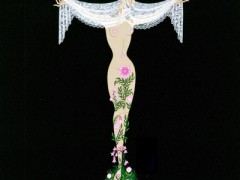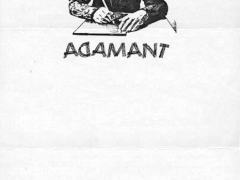Shawn Hazen’s top 10 favorite type only album covers
Started in mid-2012, Typophonic as an amazing collection that will inspire any typophile who appreciates letterforms and music alike. Masterminded by Shawn Hazen, a graphic designer himself whose career spans across many platforms, it’s a collection of “typographically driven 12-inch record covers from the 1950s through the 1980s. Some of the sleeves are type-only and some use type as a key element of the design. They’re all unique and speak to what was special about this area of design that has often been the most dynamic and experimental outlet for graphic designers.
Album covers are a great window into the visual spirit of an era or subculture, and the type they use can be the most expressive part of the artwork” says the man who started his career in San Francisco where he joined the international firm MetaDesign, explored his skills in the editorial field as a designer for San Francisco publisher, Chronicle Books, he became Senior Designer for architecture and design magazine Dwell, where he established the magazine format amongst others and has spent 2-1/2 years developing design solutions across all Apple Computer’s brand channels. Since the beginning of 2008, Shawn founded Hazen Creative, Inc and throughout his adventures in the design field, music is his partner in crime.
Meant as an inspiration for designers who create and push typography or just obsess about its form and layout, Typophonic explores type’s connotations and emotive power. We asked him to choose his top ten typographic album covers and we enjoyed his spirit and humour as much as his willingness to share two of his passions with us. So, put on your headphones, let your senses trip down memory lane and discover the amazing combo that type and music is.
Typeroom: How long have you been building this project?
Shawn Hazen: Well, honestly, I began collecting vinyl records just for the artwork about 15+ years ago. You used to be able to get one of the original, classic Blue Note records for $25 on eBay. I bought a few of those—including Rumproller, which is in my top 10 here. Eventually I became an avid record collector—for the music itself, that is. Then in mid-2012 I started Typophonic.
TR: What inspired you to do so?
SH: As I got more and more records, I started to see the typographic thread running through—or “threads” since the styles vary so wildly, but all have such an impact on the presentation of the music. I have had many blogs over the years, a few that have very specific niches like Bookworship and Gridness and I love the single-subject design blogs like those—diving deep into a specific design idea.
TR: What is the link between typography and music?
SH: Typography conveys a style that captures the flavor of the music. Whether it’s flamboyant funk or a hyper-minimal ECM cover. Every “zeitgeist” has its associated type, and members of the subculture identify with the type from their world.
TR: How important is type in packaging of a subculture?
SH: Incredibly powerful. Type from album covers can help define the entire look of a genre: the Sex Pistols’ cut-and-paste punk type, pointy heavy metal logos, or Designer’s Republic’s techno typography. It creates an instant connection—take a generic band name like “Dogs”—they could set their name in ransom type if they’re punk, looming knife-shaped letters for metal, or interlocking severely geometric computer type for techno. It probably really started with Reid Miles’ work for Blue Note, which was so unique but then became “standard”, with all the jazz labels trying to get that feel. Type as an identifier of subcultures was really cemented by the psychedelic movement—all that nearly-impossible-to-read text on the Fillmore posters was like a secret hippie language.
TR: Vinyl sales are surging nowadays. Do you think this will eventually lead to a new generation of graphic designers who will dedicate their skills solely to this market?
SH: I think most graphic designers still long to design album covers! Even if they were born after the heyday of the physical object, there’s something special about doing design for music. Music is one of the few artistic endeavors everyone “gets” so designing the accompanying visuals is a big deal. And music and musicians will always be cooler than us average slobs, so getting to participate in that rarified world is exciting. The fun thing about album covers for designers is they can be conceptual—like a poster—but can also be hyper stylized and abstract and just evocative—there’s a lot of freedom and experimentation possible. The vinyl resurgence has meant that the package is more important than ever. Think of how often you hear “being able to hold it in your hand and look at the artwork” as one of the main reasons people are going back to vinyl. New albums and re-releases need to offer something special with the packaging. Even with the vinyl itself—I have a 2-record release from Majeure where one side of one record is just engraved with this amazing pattern/artwork. It adds to the mystique and is just plain cool.
TR: Which is the first album cover you admired the most?
SH: The earliest I can think of an album cover really having an effect on me would have probably been Twisted Sister or Van Halen—trying to master drawing their logos! I grew up in Seattle and was in bands, so the everything happening in the 90s there was a huge deal to me. I still have a soft spot for the rough DIY aesthetic because of those years, but shortly thereafter I got really into the Pixies, and the refinement and lushness of the 4AD stuff is worlds away from that.
TR: If you were a font which one would you be?
SH: Akzidenz Grotesk Condensed Extra Bold because it’s tall and narrow but might look better if it wasn’t quite so heavy. Just like me. And after a few beers, I’m the italic.
TR: If you were a music genre which one would you be?
SH: Probably jazz fusion because it’s super nerdy and pretentious. It’s a bit of a mish-mash and can get overly bogged down by technical stuff but can still let loose and get funky.
TR: Please name kindly a typographer/graphic designer you admire the most.
SH: I have a totally separate set of influences for my professional practice (idols like Chermayeff and Geismar or Vignelli). For record design specifically, the kings are undoubtedly Hipgnosis. Their designs are more visual and conceptual than typographic, a notable exception being the XTC record in my 10 picks. Otherwise, I love the unsung (sorry!) heroes of custom typography like Gerard Huerta, who did the Tony Williams record I have in my top 10. But he’s even more known for wild, dimensional 80s-style script. There were so many people that were true type craftsmen. There’s a new generation of lettering artists—maybe if the vinyl resurgence sticks around, they’ll carry on the tradition.
TR: Who is the most important music related graphic designer today?
SH: I think the guys at Non-Format are modern masters. They’ve got an instantly recognizable style, but bend it to fit different genres. But it’s tough to pinpoint many people who do enough album covers to have a big impact. Poster design is more common—Jason Munn and Sonnenzimmer are favorites of mine as far as music posters.
TR: Which is the best music to accompany this top ten list of yours?
SH: I would say you should play the albums that the type appears on—it’s really interesting to see how the music compares to the type. I have bought a lot of records based on the way the band’s name was designed because it gives you a pretty good idea of what they sound like. Not always, though! Some funk bands have logos that look more like heavy metal, and for awhile everyone had trippy, psychedelic type, no matter what they sounded like!
Tags/ inspiration, music, album covers, typophonic, shawn hazen, blue note, vinyl, collection, hazen creative


























